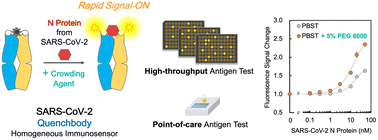Rapid and sensitive SARS-CoV-2 detection using a homogeneous fluorescent immunosensor Quenchbody with crowding agents†
Abstract
Antigen tests for SARS-CoV-2 are widely used by the public during the ongoing COVID-19 pandemic, which demonstrates the societal impact of homogeneous immunosensor-related technologies. In this study, we used the PM Q-probe and Quenchbody technologies to develop a SARS-CoV-2 nucleocapsid protein (N protein) homogeneous immunosensor based on a human anti-N protein antibody. For the first time, we uncovered the crowding agent's role in improving the performance of the double-labeled Quenchbody, and the possible mechanisms behind this improvement are discussed. The 5% polyethylene glycol 6000 significantly improved both the response speed and sensitivity of SARS-CoV-2 Quenchbodies. The calculated limit of detection for recombinant N protein was 191 pM (9 ng mL−1) within 15 min of incubation, which was 9- to 10-fold lower than the assay without adding crowding agent. We also validated the developed immunosensor in a point-of-care test by measuring specimens from COVID-19-positive patients using a compact tube fluorometer. In brief, this work shows the feasibility of Quenchbody homogeneous immunosensors as rapid and cost-efficient tools for the diagnosis and high-throughput analysis of swab samples in large-scale monitoring and epidemiological studies of COVID-19 or other emerging infectious diseases.

- This article is part of the themed collection: Analyst HOT Articles 2022


 Please wait while we load your content...
Please wait while we load your content...